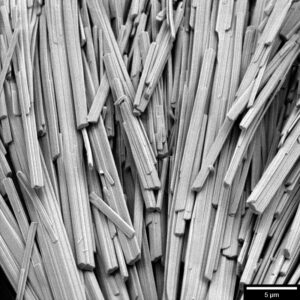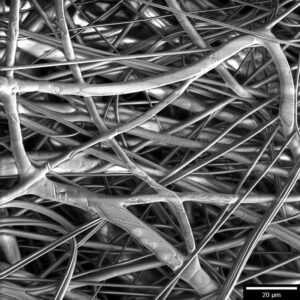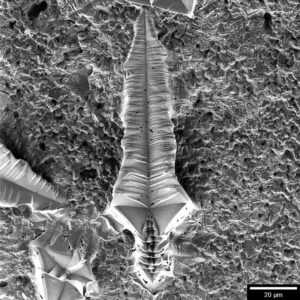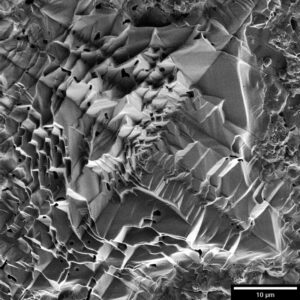Reveal the finest topographic details from insulating, beam sensitive and outgassing samples, in low vacuum and without conductive surface coating

Erythrite (Co3(AsO4)2 • 8H2O), a secondary hydrated cobalt arsenate mineral, captured at 3 keV using GSD detector and MultiVac on CLARA SEM
Sample topography characterization at low keV is an essential SEM function, because less beam penetration depth enhances topographical contrast and reveals fine surface details — details which would not be evident at higher beam energies due to the electron transparency of charging samples. TESCAN’s MultiVac option for TESCAN SEMs enables more efficient characterization of non-conductive, charging, or beam sensitive samples when using low keV imaging, by combining a gaseous secondary electron detector (GSD) with low vacuum and extended variable pressure operation.
MultiVac operates in N2 and H2O atmospheres as well as in the 10-500 Pa pressure range. MultiVac’s gaseous secondary GSD, when used in H2O atmosphere, enhances contrast and enables high resolution imaging at low keV and low current for topographic characterization on charging or beam sensitive samples. Unlike in low vacuum mode, where gas molecules decrease signal collection efficiently, the GSD in a variable pressure H2O atmosphere enhances the SE signal to produce detailed images easily at low keV and low beam current. Additionally, the water vapor atmosphere mitigates contamination of the sample’s surface during electron beam scanning.
MultiVac seamlessly integrates with TESCAN SEMs and is controlled directly from TESCAN’s Essence™ software, to make high quality characterization effortless and accessible to all users.
Key Benefits
- Capture charge-free images of any insulating sample with the finest detail — without metal surface coating — by taking advantage of extended and variable pressure range (10-500 Pa).
- Obtain high magnification, detailed topographic (SE) information from charging samples at low accelerating voltages using the gaseous secondary electron detector (GSD) in water vapor atmosphere.
- Characterize topography of unprepared and outgassing samples with the GSD, which delivers high quality results at chamber pressure >400 Pa.
- Image samples without surface carbon contamination caused by the electron beam exposure during the imaging using advantages of oxygen contained in water of MultiVac atmosphere.
- Acquire both detailed topographic (SE) and material contrast (BSE) information from your sample, at low landing energies and in low vacuum, by combining the GSD with TESCAN’s own low energy BSE detector.
- Accelerate and streamline your low vacuum imaging routines for large dimension or high volumes of samples by complementing MultiVac with TESCAN’s Optical Navigation and Correlation Camera mounted on a TESCAN GM chamber.
- Observe samples sensitive to deformation in high vacuum — biological, polymers, soft materials — without significant vacuum degradation by pumping down to the low vacuum regime of the SEM (500 Pa)





